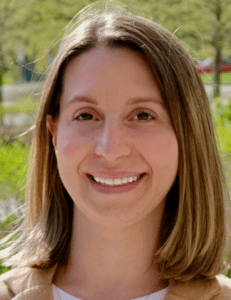Posted By: HGG Advances
Each month, the editors of Human Genetics and Genomics Advances interview an early-career researcher who has published work in the journal. This month we check in with Nina Gold (@nbgmd) to discuss her paper Phenotypes of undiagnosed adults with actionable OTC and GLA variants.

HGGA: What motivated you to start working on this project?
NG: Although monogenic genetic disorders are individually rare, collectively they affect up to 1 in 20 people in the global population. Over 700 monogenic disorders—including many inherited metabolic disorders, which I study and treat clinically—now have targeted treatments. As more therapies become available, the need to identify at-risk people early has become more urgent. A “genome-first approach,” like the one that we used in this project, provides an opportunity to improve patient outcomes by screening apparently healthy people for genetic disorders prior to the onset of severe symptoms.
HGGA: What about this paper/project most excites you?
NG: In this paper, we identified people with undiagnosed pathogenic variants in OTC and GLA, genes associated with two inherited metabolic disorders. The low prevalence of these variants in two hospital biobanks suggests that, if we were to scale genomic screening for these conditions to a population level, there would not be a large number of individuals with positive results who would place a new burden on our small workforce of medical geneticists. Many participants in our study had some symptoms of disease and might benefit from further evaluation and surveillance to prevent worsening of their symptoms.
HGGA: What do you hope is the impact of this work for the human genetics community?
NG: If implemented well, screening for monogenic disease-associated variants could improve public health. But first, we need to better understand the penetrance and expressivity, and accordingly the positive predictive value, of these variants. When apparently healthy people have disease-associated variants, how likely are they to develop symptoms and need treatment? We are still learning that for many conditions. We need to be cautious before we apply risky or costly therapies to people who may not need them.
HGGA: What are some of the biggest challenges you’ve faced as a young scientist?
NG: I am grateful to have two beautiful kids, ages 1 and 3, and I’ve shaped my career around them. This means that I sometimes keep an unusual schedule and my colleagues have become accustomed to receiving emails from me at very odd hours! Two of my fellow physician-scientist moms (who are both co-authors on this paper), Dr. Alanna Strong and Dr. Jessica Gold, help me keep going. We share our daily struggles and successes. I hope to hold on to their friendship and collaboration for years to come.
HGGA: And for fun, what is one of the most fascinating things in genetics you’ve learned about in the past year or so?
NG: I am absolutely fascinated by prenatal therapies for inherited metabolic disorders, such as lysosomal storage disorders or cobalaminopathies. We have an incredible opportunity to improve the health of individuals affected by these conditions before they are even born.
